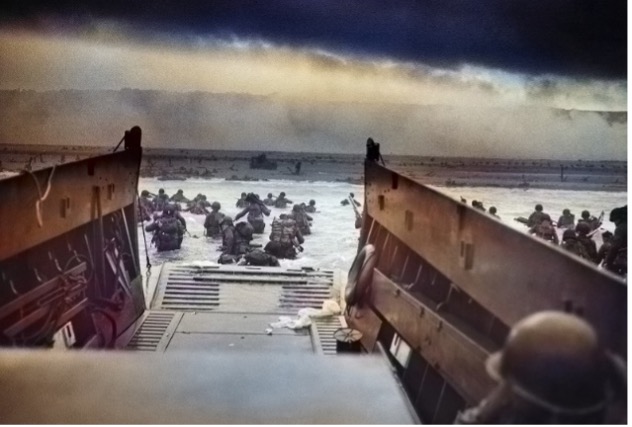
- Causes of WWII:
- The Peace of Paris –The treaties worked out in Paris at the end of WWI satisfied few. Germany and Austria were especially unhappy with the Paris Agreement, which required them to give up arms and make reparations. Germany agreed to sign the Treaty of Versailles only after the victorious countries threatened to invade if they didn’t sign. Germany made their last reparation payment in 2010.
- Economic Issues – WWI was devastating to countries’ economies. Although the European economy had stabilized by the 1920s, the Great Depression in the U.S. led to economic downfall in Europe. Communism and fascism gained strength in the wake of these economic problems.
- Nationalism – An extreme form of patriotism which had been growing in Europe became even stronger after WWI, especially in the defeated countries.
- Dictatorships – Political unrest and unfavorable economic conditions lead to the rise of dictatorships in countries such as Germany, Italy, Japan, and the Soviet Union.
- Failure of Appeasement – Czechoslovakia had become an independent nation after WWI, but by 1938, was surrounded by German territory. Hitler wanted to annex the Sudetenland, an area in western Czechoslovakia where many Germans lived. British Prime Minister Neville Chamberlain wanted to appease Hitler and agreed to his demands for the Sudetenland after Hitler promised he wouldn’t demand more territory. Hitler seized the rest of Czechoslovakia in March,1939.
- World War II formally began on September 1, 1939 when Germany invaded Poland without a formal declaration of war. In support of their mutual defense treaty obligations with Poland, France and Great Britain issued ultimatums to Hitler for the immediate withdrawal of German forces from Poland. When the ultimatum deadlines expired, Great Britain and France declared war on Germany on September 2, 1939. Denmark, Luxembourg, the Netherlands, Norway, Belgium, and France soon fall under German control.
- On June 10, 1940, Italy joins the war on the side of Germany by declaring war against Britain and France. Fighting spreads to Greece and Northern Africa. Germany, Japan and Italy formed a coalition called the “Axis Powers.” Bulgaria, Hungary, Romania, and two German – created states (Croatia and Slovakia) eventually joined.
- The “Big Three” was a term used after the summer of 1941 to denote the leaders of the three major powers opposing Germany, Italy, and Japan during World War II: Roosevelt (U.S.), Churchill (Great Britain), and Stalin (the Soviet Union). The term was also used in reference to the three Allied countries themselves. The “Big Three” was expanded to the “Big Four” when China joined the Allies. The “Big Four” nations later played a major role in establishing the United Nations. At least 50 nations would eventually fight for “the Allies.”
- Hitler wanted to create what he thought was the “best” and strongest race – and to the Nazi Party, this excluded certain groups, such as Jews, Gypsies and those with physical and mental disabilities. In an attempt to eliminate a “racial enemy” outside of Germany, such groups were also persecuted in the countries invaded by German forces.
- The group most heavily targeted by the Nazis were the Jews. Around six million Jewish people were killed during WWII in one of history’s most terrible events –the Holocaust. Racist in his views, Hitler blamed Jewish people for Germany losing WWI and claimed they were dangerous to German people and society.
- Around the same time that Germany fought for power in Europe, Japan wanted to control Asia and the Pacific. In 1937(before WWII had officially begun) under Emperor Hirohito, Japan attacked China, bringing the two nations into years of conflict.
- On December 7, 1941, the Japanese military launched a surprise attack on the U.S. Naval Base at Pearl Harbor. The attack killed 2,403 service members and wounded 1,178 more, and sank or destroyed six U.S. ships. They also destroyed 169 U.S. Navy and Army Air Corps planes. President Roosevelt called the attack “a date which will live in infamy,” and the very next day, the U.S. declared war on Japan and, in turn, its German allies.
- Following the attack on Pearl Harbor, 600,000 or so legal Italian aliens living in the U.S. were placed under restrictions. Among the restrictions were prohibitions on traveling more than five miles from home; curfews from 8 p.m. to 6 a.m.; confiscation of shortwave radios, firearms, cameras, flashlights, and other “signaling devices;” and evacuation from coastal towns. 1,600 or so Italians were interned in a network of camps across the U.S., but primarily in Missoula, MT. The restrictions against the Italians were lifted in October 1942, although it wasn’t until the Italian surrender in September 1943 that most internees were released.
- Similar restrictions were also placed on German legal aliens in the U.S. during WWII. Such restrictions included curfews, confiscation of personal property, travel restrictions, and evacuations from coastal towns. Approximately 10,905 Germans were interned in camps across the U.S., including Missoula, MT, and Crystal City, TX. The last German internees were released in 1948.
- President Roosevelt signed Executive Order 9066 in February 1942, calling for the internment of Japanese – Americans after the attacks on Pearl Harbor. Some 117,000 people would be forced into prison camps scattered throughout the U.S. by that June.
- Nuclear fission was discovered in February 1939 by scientists in Germany. FDR was informed personally of the discovery and its potential in October 1939 when scientist Alexander Sachs read aloud Albert Einstein’s letter warning the president of fission’s military implications. Based on Einstein’s letter and concepts of scientists working in Britain, FDR set up a joint Anglo-American effort to produce atomic bombs for potential use during the war. The result was the Manhattan Project which would ultimately create the weapon. In August 1943 at the Quebec Conference, FDR and Churchill signed a secret agreement governing collaboration between the two countries on the development of the atomic bomb. The first successful test of the atomic bomb occurred on July 16, 1945 in Alamogordo, NM.
- Spain, Portugal, Sweden, and Switzerland declared “neutrality” during WWII.
- June 4-6, 1942 – Japan’s plans to invade the Hawaiian Islands, starting at Midway Island, but the U.S. cracks the code of the mission. Japan attacks Midway and loses four aircraft carriers and over 200 planes in the first clear victory for the U.S.
- July 10, 1943 – Allied forces land in Italy. On July 25, the King of Italy is restored to full power, and Mussolini is deposed and arrested. (Mussolini is killed attempting to escape to Switzerland on April 28, 1945.)
- On June 6, 1944, General Eisenhower gave the go-ahead for the largest amphibious military operation in history: Operation Overlord, code named D-Day, the Allied invasion of northern France. He called the operation a crusade in which “we will accept nothing less than full victory.” Over 5,000 ships, 11,000 airplanes, and 156,000 American, British, and Canadian troops stormed 50 miles of Normandy’s fiercely defended beaches. The cost of lives was high. More than 9,000 Allied soldiers were killed or wounded. However, their sacrifice allowed 100,000+ soldiers to begin the slow trek across Europe to defeat Hitler’s troops.
- Before the Allied assault on June 6, Hitler’s armies had been in control of most of mainland Europe. The Allies felt a successful invasion of the continent was central to winning the war. Hitler knew this too, and was expecting an assault on northwestern Europe that spring. He hoped to repel the Allies from the coast with a strong counterattack, giving him time to throw the majority of his forces into defeating the Soviet Union in the east. Once that was accomplished, he believed an all-out victory would soon be his.
- For their part, the Germans suffered from confusion in the ranks and the absence of their celebrated commander, Field Marshal Erwin Rommel, who was away on leave. The Germans were hampered by effective Allied air support (which took out many key bridges and forced the Germans to take long detours), as well as efficient Allied naval support, which helped protect advancing Allied troops.
- Though D-Day did not go off exactly as planned – for example, the Allies were able to land only fractions of the supplies and vehicles they had intended in France – the invasion was a success. By the end of June, the Allies had 850,000 men and 150,000 vehicles in Normandy, and were poised to continue their march across Europe.
- On August 25, 1944, American and Free French forces liberate Paris.
- In April, 1945: Roosevelt dies in Warm Springs, GA. VP Truman takes the oath of office as President; Soviet troops surround Berlin; U.S. soldiers liberate Dachau concentration camp outside of Munich; and Hitler and wife Eva Braun commit suicide.
- May 8, 1945, V-E Day. The war in Europe is officially over.
- An atomic bomb, code named “Little Boy,” was dropped over Hiroshima Japan on August 6, 1945. The bomb, which detonated with an energy around 15 kilotons of TNT, was the first nuclear weapon deployed in wartime. 140,000 were killed. On August 9, 1945, after getting no response from the Japanese government after the Hiroshima bombing, a second atomic bomb, nicknamed “Fat Man,” is dropped on Nagasaki, killing up to 80,000.
- On August 14, 1945,Japan unconditionally agrees to accept the terms of the Potsdam Declaration and end the war. Victory over Japan (V-J) Day is declared.
- WWII proved to be the deadliest international conflict in history, taking the lives of 60 to 80 million people. Civilians made up an estimated 50-55 million deaths from the war, while military comprised 21 to 25 million of those lost during the war.
- U.S. troop statistics:
- Number of troops who served in the conflict: 16,112,566
- Number of wounded: 291,557
- Number of deaths: 291,557 (in Battle); 113,842 (non-Battle)
- Canadian troop statistics:
- Number of troops who served in the conflict: 1.1 million
- Number wounded: 55,000+
- Number of deaths: 45,000+
- The Soviet Union lost the most soldiers, in excess of seven million.
- The legacy of the war would include the spread of Communism from the Soviet Union into eastern Europe as well as its eventual triumph in China, and the global shift in power from Europe to two rival superpowers – the U.S. and the Soviet Union – who would soon face off against each other in the Cold War.
- In 1948, the United States created the Marshall Plan to help rebuild war torn Europe. Eventually, 18 nations received $13 billion in food, machinery, and other goods.
- In March 1974, Hiroo Onoda, a Japanese soldier still fighting the war, was found by a search party on the island of Lubang in the Philippines. After he was convinced that the war was over by his former commanding officer, he was flown to Manila and formally surrenders to Pres. Ferdinand Marcos. Onoda died in January 2014, at 91.
- The National World War II Museum, located in New Orleans keeps statistics on WWII veterans across the country. Their numbers show that of the 16 million men and women who served in WWII, only about 119,000 are still alive today. But what’s more shocking is how often we’re losing those men and women. The museum says each day, 131 of those veterans die.






